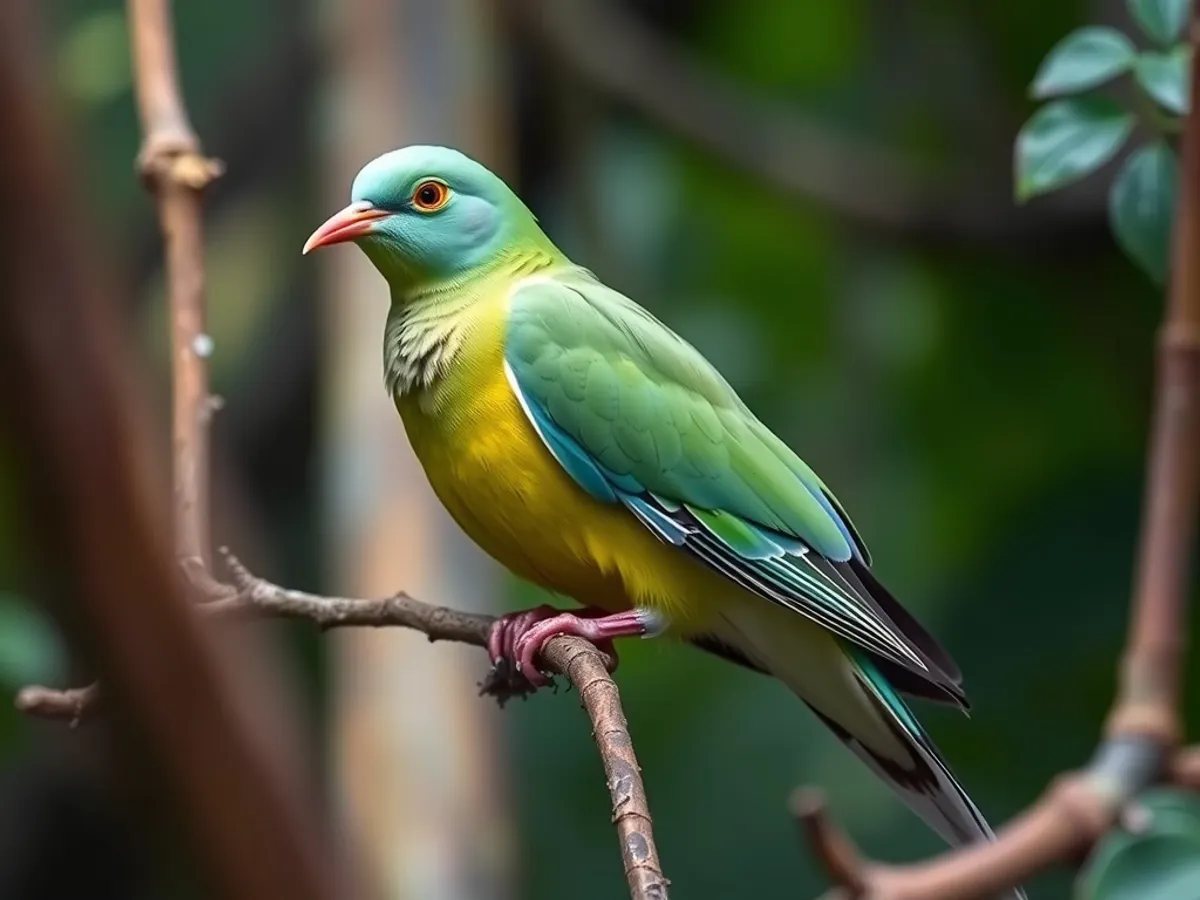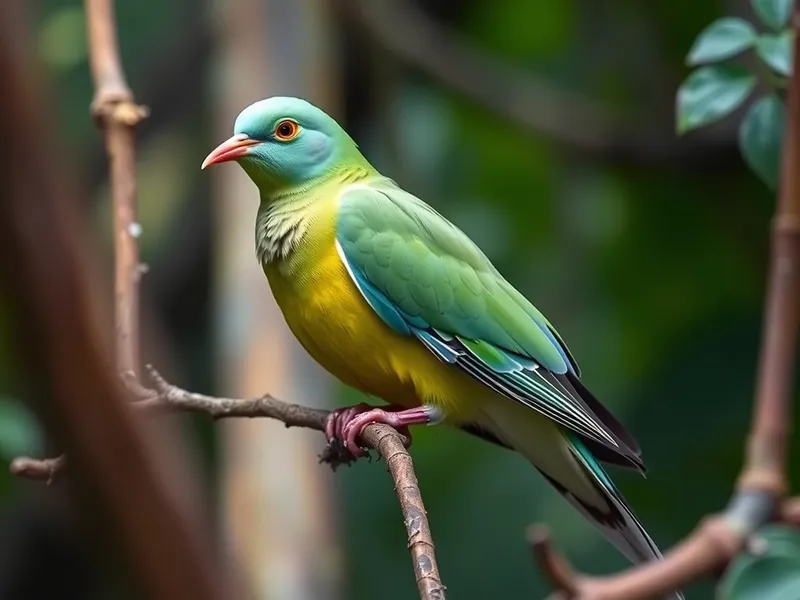
Superb Fruit Dove
Ptilinopus superbus

Meet the Superb Fruit Dove
The Superb Fruit Dove is a small, vibrantly colored pigeon native to Australasia, renowned for its striking plumage. Males display a vivid mix of green, orange, purple, and white feathers, while females are primarily green for camouflage. This species inhabits dense rainforests, where it plays a crucial role in seed dispersal through its frugivorous diet. Superb Fruit Doves are typically shy and elusive, spending much of their time in the forest canopy and rarely descending to the ground.
Classification
Bird
Habitat
Tropical and subtropical rainforests
Diet
Frugivore
Lifespan
5-10 years
Conservation
Least Concern
Weight
85-125 g
📖Fascinating Facts
Fruit Specialist
Superb Fruit Doves feed almost exclusively on fruits and berries, particularly figs, playing a vital role in rainforest regeneration by spreading seeds.
Canopy Dweller
They spend most of their lives high in the canopy, rarely coming down to the ground, making them elusive to observers.
Colorful Plumage
Males boast brilliant green, purple, orange, and white feathers, while females are mostly green for camouflage against leafy backgrounds.
📋Detailed Description
The Superb Fruit Dove (Ptilinopus superbus) is a compact, medium-sized pigeon measuring approximately 22–24 cm in length and weighing around 90–110 grams. Males are particularly striking, featuring a purple crown, orange nape, blue-grey breast band, and a white lower belly, contrasted with vibrant green wings and back. Females, in contrast, are predominantly green with a lighter green belly and lack the vivid head markings, an adaptation for camouflage among foliage. The species has a short, rounded tail and strong, zygodactyl feet adapted for perching on slender branches. Superb Fruit Doves are arboreal and rarely descend to the ground, spending most of their lives in the mid to upper canopy of dense rainforests. Their eyes are relatively large, aiding in fruit detection among dense leaves. The species is known for its soft, low-pitched cooing calls, which are often the only indication of their presence. These doves are solitary or found in pairs but may gather in small groups at abundant fruiting trees. Their flight is swift and direct, with rapid wingbeats, allowing them to navigate efficiently through dense forest canopies.
💡 Did you know?
Despite their dazzling colors, Superb Fruit Doves can be extremely difficult to spot in the wild due to their small size and the dappled light of the rainforest canopy.
🔬Research & Sources
Wikipedia Summary
The superb fruit dove, also known as the purple-crowned fruit dove, is a medium-sized, colourful fruit-dove in the family Columbidae.
Last Modified: 12/20/2023
🎭Behavior & Social Structure
Superb Fruit Doves are primarily diurnal, foraging for fruit during the early morning and late afternoon when activity is highest. They feed almost exclusively on fruit, especially figs (Ficus spp.), drupes, and berries from a wide variety of rainforest trees and vines. Their feeding behavior involves carefully plucking fruit with their bills and swallowing it whole; they are capable of consuming fruits up to 2 cm in diameter. While generally solitary or in pairs, they may form loose aggregations at trees with abundant fruit. Their movements are generally inconspicuous, and they rely on their cryptic coloration and stillness to avoid detection by predators. Superb Fruit Doves maintain small, overlapping home ranges and are not strongly territorial. They communicate with a series of soft, repetitive coos, which serve both to maintain contact between mates and to advertise their presence during the breeding season.
👶Reproduction & Life Cycle
Breeding occurs throughout the year in equatorial regions, with peaks during periods of fruit abundance. In Australia, the main breeding season is from September to January. Superb Fruit Doves are monogamous, forming long-term pair bonds. Courtship involves the male performing a display flight and bowing movements, accompanied by soft vocalizations. The female lays a single white egg on a flimsy platform nest constructed of twigs, usually placed 5–20 meters above ground in dense foliage. Both parents share incubation duties, which last about 14–16 days. After hatching, the chick is fed regurgitated fruit pulp by both parents and fledges at around 12–14 days old. Parental care continues for several days post-fledging as the young bird learns to forage independently.
🛡️Adaptations & Survival
Superb Fruit Doves exhibit several adaptations for an arboreal, frugivorous lifestyle. Their strong, grasping feet and short, rounded wings facilitate agile movement through dense foliage. Their cryptic coloration, especially in females, provides effective camouflage from aerial and arboreal predators. The digestive system is specialized for processing a fruit-heavy diet, with a muscular gizzard capable of breaking down tough fruit skins and seeds. Their large gape allows ingestion of relatively large fruits, and they play a key ecological role as seed dispersers. The species' low, ventriloquial calls are adapted for communication in dense forest environments, minimizing detection by predators.
📚Research Sources
🎨Cultural Significance
While not a major figure in folklore or mythology, the Superb Fruit Dove is admired for its beauty and is a favorite among birdwatchers and ecotourists in Australasia. Its presence is often used as an indicator of healthy rainforest ecosystems. In some indigenous cultures in New Guinea, fruit doves in general are occasionally hunted for food, but the Superb Fruit Dove is not a primary target due to its elusive habits.
🔬Recent Research & Discoveries
Recent research has focused on the Superb Fruit Dove's role in seed dispersal and its dependence on intact rainforest ecosystems. Studies using radio telemetry have revealed detailed patterns of home range use and habitat preference, emphasizing the importance of large, contiguous forest areas. Genetic analyses have confirmed the species' close relationship with other Ptilinopus fruit doves and highlighted the potential for cryptic speciation within the group. Ongoing research is examining the impacts of climate change on fruiting phenology and the potential consequences for frugivorous birds like the Superb Fruit Dove.
🎥Wildlife Videos

Many-colored Fruit Dove | Toledo Zoo Conservation
Learn more about the Toledo Zoo's conservation work, both in American Samoa and the Aviary, with the imperiled Many-colored ...
Toledo Zoo

Beautiful Wild Birds Eating Fruits With beautiful Wild Nature..#birds #animals #wildlife #nature
Beautiful Wild Birds Eating Fruits With beautiful Wild Nature..#birds #animals #wildlife #nature.
Blue bird's in blue world

Birds short documentary || Birds documentary || Birds || Bird sounds || SOUL NATURE
Birds short documentary || Birds documentary || Birds || Bird sounds || SOUL NATURE Birds and wildlife videography. It is a short ...
SOUL NATURE

1 Most Beautiful Bird Dove Nature of Birds some good ways to relax by nature videos Birds Collection
In this video, we're going to be looking at one of the most beautiful birds in the world - the dove. We're going to see some good ...
The Nature Show

Negros Bleeding Heart Dove: Our Conservation Work with Toledo Zoo
In 2021, Bristol Zoological Society partnered with Toledo Zoo and the Talarak Foundation to reintroduce the Critically Endangered ...
Bristol Zoo Project

Flying Fox: The Rainforest's Winged Gardeners
Embark on a captivating journey with "Flying Fox: The Rainforest's Winged Gardeners," a stunning exploration of one of the most ...
Earth's Living Odyssey
🌍Habitat Information
The Superb Fruit Dove typically inhabits Tropical and subtropical rainforests environments. Superb Fruit Doves have adapted to their environments with specialized features and behaviors.
Primary Habitat:
Tropical and subtropical rainforests
More detailed habitat information will be available soon.
🛡️Conservation Status
The Superb Fruit Dove is currently classified as Least Concern. Conservation efforts are crucial for preserving this species for future generations.
Common Threats:
- 🏠Habitat loss and fragmentation
- 🌡️Climate change impacts
- 🎯Hunting and poaching
- 🏭Human-wildlife conflict
⚠️Threats & Conservation Challenges
Currently assessed as Least Concern by the IUCN, the Superb Fruit Dove faces localized threats from habitat loss due to deforestation, logging, and land conversion for agriculture, particularly in parts of its range in New Guinea and eastern Australia. Fragmentation of rainforest habitat can limit access to fruiting trees and reduce breeding success. The species is sensitive to disturbance and does not adapt well to secondary or degraded forests. Climate change poses a long-term threat by altering fruiting phenology and reducing the availability of key food plants. Despite these challenges, the species remains relatively common in extensive, undisturbed rainforest tracts.
🔬Scientific Classification
Scientific Name
Ptilinopus superbus
Classification Hierarchy
🔍 About Taxonomic Classification
Taxonomic classification is a hierarchical system used by scientists to classify and organize living organisms based on shared characteristics and evolutionary relationships.
The system moves from broad categories (Kingdom) to increasingly specific ones, with each animal's scientific name typically consisting of its Genus and species.
📝Community Notes
Share your observations and insights about the Superb Fruit Dove with our community of wildlife enthusiasts.
Join Our Community
Sign in to share your observations and connect with fellow wildlife enthusiasts.
Sign In to ContributeNo community notes yet
Be the first to share your observations about the Superb Fruit Dove!
Explore Superb Fruit Dove
Select a tab above to learn more about this amazing animal.
📸Photo Gallery
No photos available for this animal yet.
🌟Discover More Wildlife
Continue your journey of discovery with more fascinating animals from our database
